-
Seedshop
-
Feminized
Cannabis seeds -
Autoflowering
Cannabis Seeds -
Regular
Cannabis Seeds -
F1 Hybrid
Cannabis Seeds -
CBD
Cannabis Seeds -
Zamnesia
Cannabis Seeds
-
Top 10’s
- Top 10 Feminized Seeds
- Top 10 Autoflowering Seeds
- Top 10 Regular Seeds
- Top 10 USA Cannabis Strains
- Top 10 Zamnesia Seeds
-
Favourites
- Beginner Strains
- Below 1% THC
- Classic Cannabis Strains
- Cup Winners
- F1 Hybrids
- Fast-Flowering Strains
- High CBD Strains
- High THC Strains
- Mix Packs
- Zamnesia Exclusive Collabs
-
-
Headshop
-
Vaporshop
- Spare Parts & Accessories
- AirVape X
- AirVape XS GO (2021)
- Arizer Air MAX
- Arizer Extreme Q
- Arizer Solo 2
- Arizer V-Tower
- Arizer XQ2
- Boundless CFC 2.0 Vaporizer
- Boundless CFX
- Boundless TERA (V3)
- CRAFTY+
- DaVinci IQ2
- DaVinci IQC
- DaVinci MIQRO
- Dr. Dabber Boost EVO
- Dr. Dabber Stella
- DynaVap Omni 2021
- DynaVap VapCap "M" PLUS 2023
- DynaVap VapCap 'M' 2021
- DynaVap VonG (i) Titanium
- Dynavap The "B" Series
- Eagle Bill
- Firefly 2+
- Flowermate Aura
-
Healthshop
-
Smartshop
-
Shroomshop
-
Growshop
-
Seedshop
All CategoriesSeedshop
-
Vaporshop
All CategoriesVaporshop
- Top 10 Vaporizers
- Spare Parts & Accessories
- AirVape X
- AirVape XS GO (2021)
- Arizer Air MAX
- Arizer Extreme Q
- Arizer Solo 2
- Arizer V-Tower
- Arizer XQ2
- Boundless CFC 2.0 Vaporizer
- Boundless CFX
- Boundless TERA (V3)
- CRAFTY+
- DaVinci IQ2
- DaVinci IQC
- DaVinci MIQRO
- Dr. Dabber Boost EVO
- Dr. Dabber Stella
- DynaVap Omni 2021
- DynaVap VapCap "M" PLUS 2023
- DynaVap VapCap 'M' 2021
- DynaVap VonG (i) Titanium
- Dynavap The "B" Series
- Eagle Bill
- Firefly 2+
- Flowermate Aura
- Flowermate Cap Pro
- Flowermate Slick
- Flowermate V5.0S Pro
- G Pen Connect
- G Pen Elite II
- G Pen Micro+
- G Pen Pro
- G Pen Roam
- Hydrology9 Vaporizer
- Hyer Big-E Rig
- MIGHTY
- MIGHTY+
- PAX Mini
- PAX Plus
- PLENTY
- Pax 3 Vaporizer
- Puffco Peak PRO Smart Rig
- Puffco Peak Smart Rig
- Puffco Plus
- Storm Vaporizer
- The Proxy (Puffco)
- VOLCANO CLASSIC
- VOLCANO HYBRID
- Vape-Lifter
-
Smartshop
All CategoriesSmartshop
- Top 10 Smartshop
- Zamnesia Gift Cards
- After Party
- Aphrodisiacs
- Aromatherapy
- Blue Lotus
- CBD Vape Juice
- Capsule Machines
- Crystals, Gemstones & Minerals
- Dream Herbs
- Drug Tests
- Extracts
- Happy Caps
- Herbal Tea
- Herbs & Seeds
- Incense
- Kanna
- Kratom
- LSA Seeds
- Mescaline Cacti
- Microdosing
- Nootropics
- Relaxing
- Salvia divinorum
- Smart Seeds
- Stimulants
- Supplements
- Tinctures
- Vape Herbs
-
TRIBE
All CategoriesTRIBE
- My Membership
- Spend Gift Points
- Exclusive products
- Earn Extra Gift Points
-
TRIBE
- Early Access
- Refer a Friend
- Information
-
TRIBE
-
Language
 United States
United States
Friday, 18 April and Thursday, 24 April 2025*
- Zamnesia >
- Peppershop >
- Hot Peppers And The Scoville Scale
Hot Peppers And The Scoville Scale
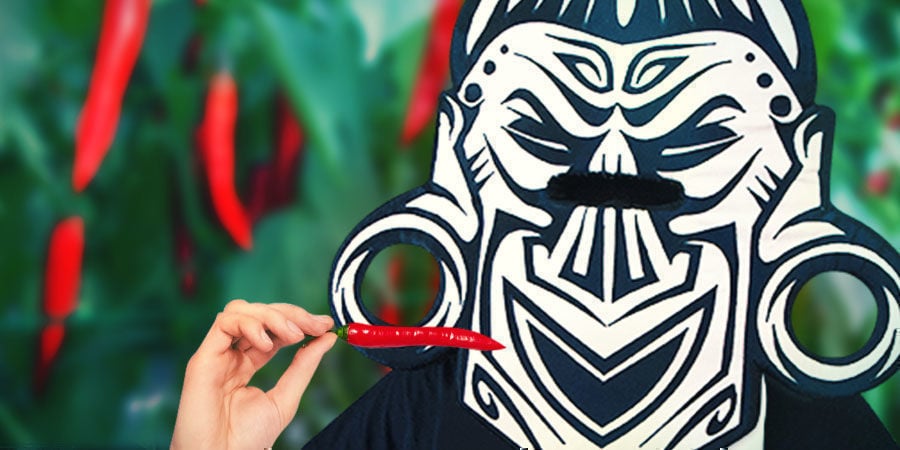
There's no denying the appeal of spicy food. Whether you're keen on Mexican delicacies, Pad Thai, or Vindaloo curries, they have one thing in common; peppers.
With the powerful flavors and heat they offer, they’ve captured our taste buds and imaginations for over 6000 years. But what, you may wonder, makes peppers hot in the first place? Which ones are the hottest? We’ll be answering both these questions and more as we go along.
What Makes Peppers Hot?
There are a few common misconceptions when it comes to peppers. For instance, you may automatically assume the red ones are going to blow your head off; red means danger, right? While this can sometimes be the case, it's not as bad as you'd expect (most of the time, anyway). But that brings us back to the question: what makes peppers hot?
Many people believe it comes down to the seeds, but that isn’t really the case. The heat in chilies, rather, can be traced to the chemicals contained inside. These chemicals are known as capsaicinoids, and there are many different varieties out there. The main one, which you might be familiar with, is called capsaicin. It’s this component, rather than any physical part, that’s primarily responsible for the heat.
However, it is not released until the skin of the pepper is broken, causing it to disperse throughout the insides. While it may sound strange, this is actually an evolutionary defence method designed to deter animals from eating them and their seeds.
In turn, while they all have the same defense mechanism, some peppers are hotter than others. While word of mouth is enough to give us a sense of which chilies are hottest, a more formal system was created to rate them. This system is known as the Scoville Scale.
The Scoville Scale Explained
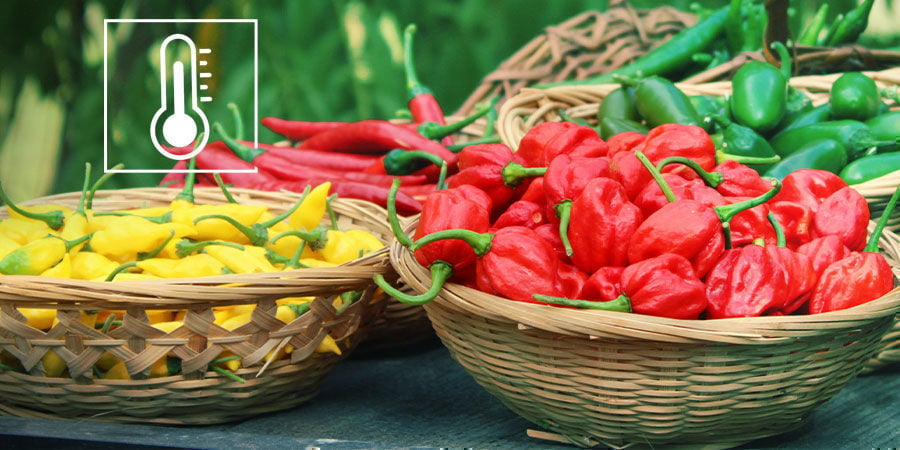
The Scoville Scale, as we just said, is a ranking system for the spiciness of peppers and spices. Ranging from the mildly sweet Bell pepper, all the way to the infamous Carolina Reaper and beyond! All are catalogued in ascending order of their hotness. Online databases will have the rankings for specific peppers, but you’ll see these numbers on bottles of hot sauces as well, along with many other products peppers are used in. In that case, it’ll denote the heat of the product based on its ingredients, often shown as a SHU (or Scoville Heat Units) number.
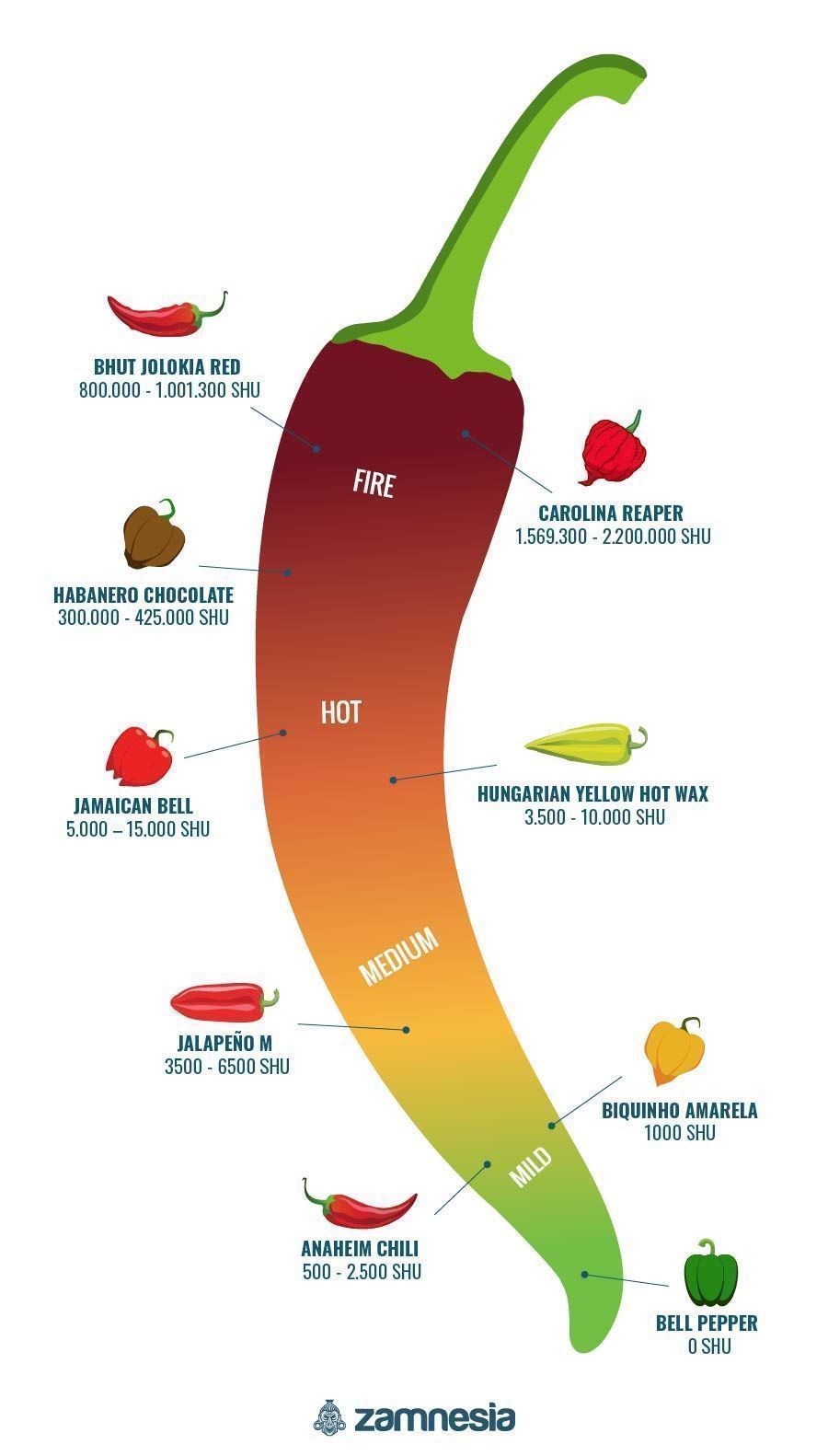

When Was The Scoville Scale Invented, And By Who?
While working as a pharmacist in 1912, Wilber Scoville devised a test of measuring the potency of a pepper. Originally known as the “Scoville Organoleptic Test”, the method involved diluting ground pepper extracts with droplets of sugar water.
Specifically, he would place these pepper extracts on the tongues of volunteers and figure out how much sugar water it would take to relieve the heat. The total amount of sugar water required to dilute each pepper would be recorded in Scoville Heat Units, creating the foundation of the measurement we know today.
How Is A Scoville Heat Unit Measured?

While sugar water dilution was indeed the foundation, the Scoville test has moved with the times. Using High-Performance Liquid Chromatography (HPLC), we’re able to get an accurate measurement of the capsaicin levels in the pepper, giving an accurate indication of the heat and where it would sit on the scale.
What Can You Use The Scoville Scale For?
Even though the Scoville Scale is primarily used to catalogue the heat levels of peppers, it, as we’ve mentioned, has other uses as well. Store-bought hot sauces, cooking spices and even spicy snacks can often be seen with a SHU indicator to let you know what you're getting into. It is also not uncommon to see SHU levels next to certain items on restaurant menus. The Scoville Scale, in turn, has become synonymous with spice, and is often discussed in day-to-day life. Even self-defence products like pepper spray feature SHU numbers on the label! We’d advise you to not add any to your food, though.
Famous Peppers and Other Items on the Scoville Scale
With every type of spice, chili and pepper catalogued on the Scoville Scale, there are many famous examples that you will either see as a challenge, an excellent addition to a dish or you'll just want to avoid any way you can!
Carolina Reaper

The hellish Carolina Reaper, as you may have guessed, sits right around the top of the scale. You couldn’t tell from looking at it, though, as it features a cute bumpy texture and small tapered tail. Couldn’t be too bad, right? Well, the Guinness World Records declared the Carolina Reaper to be the hottest chili pepper in the world back in 2013. While there are other competitors now, such as Dragon's Breath and Pepper X, none have matched the infamy of the Carolina Reaper.
Hitting the scale at 2,200,000 SHU, this is likely to be the hottest pepper you, or anyone, will ever come across. Comparatively, pepper spray (you know, the type used by police) rates at 2,500,000 SHU; that should tell you what to expect.
Ghost Pepper
Before the Carolina Reaper, there was another pepper that ruled them all: the ghost pepper. Rated at just over 1,000,000 SHU, it’s only half as spicy as the Reaper, but it‘s absolutely nothing to mess with. Despite the potential hazard, restaurants enjoy adding it to the food challenges on their menus. For example, they may offer you a free ghost pepper burrito if you’re able to eat it in 10 minutes.
Habanero Pepper
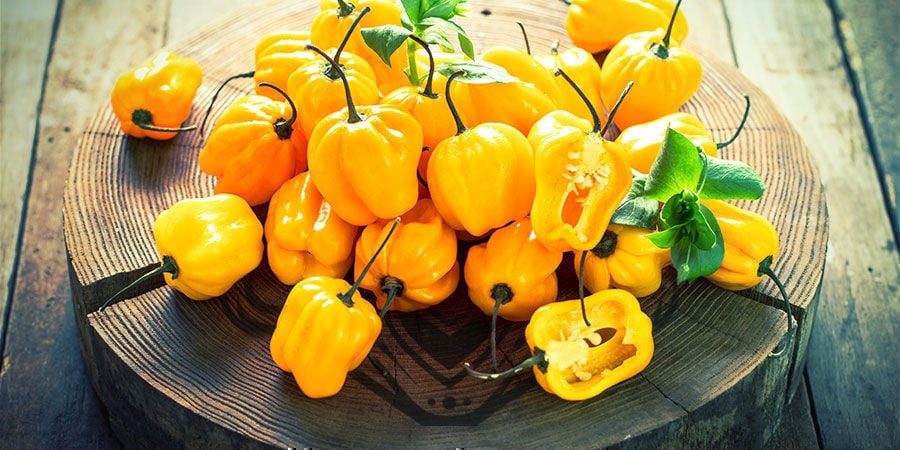
Getting to the peppers you may actually eat on a regular basis, let’s talk about the humbly hot habanero pepper. It was originally found in the Amazon, but made its way up to Mexico, and eventually around the world, over the years.
Ranking between 100,000 and 350,000 SHU, this chili has been a hugely popular ingredient in hot sauces, as well as other spicy foods served around the world.
Jalapeno Pepper
Jalapeno, arguably, are the most common chili pepper used today. You may see them on nachos, on top of pizza, or covered in cheese, battered, and fried. Wherever they are, with SHU levels ranging between 3,500 and 8,000 (depending on the pepper), jalapenos provide a level of heat that, while not overbearing, is noticeable in any dish.
They’re readily available in almost all grocery stores, whether you want them crisp and fresh or sliced and pickled.
Sriracha
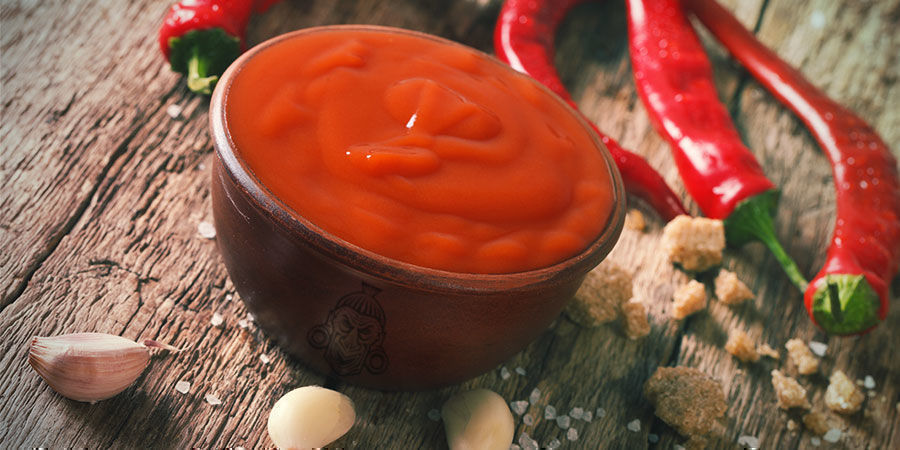
As a multi-use sauce stocked in many grocery stores, Sriracha has found its place alongside other tabletop hot sauces as a mainstream alternative. Whether you're using it as a dipping sauce or adding it to your ramen noodles, Sriracha has likely found some place in your life.
At its core, it’s a blend of chili peppers, vinegar, garlic, sugar and salt that ends up slightly hotter than Tabasco. Specifically, it measures in 1,000 to 2,500 SHU, making it one of the less capsaicin-packed hot sauces around. That however, also means it’s one of the more palatable.
Wasabi –– A Misconception
While many assume wasabi would be listed on the Scoville Scale index, it doesn’t actually contain capsaicin, so it doesn’t qualify. It’s actually a member of the Brassicaceae plant family, rather than being a pepper, so it’s more like horseradish or mustard than anything else. Regardless of absent capsaicin, however, authentic wasabi packs a powerfully spicy punch.

- France
- Germany
- International
- Italy
- Netherlands
- Spain
- United Kingdom
- United States
You might also like
-
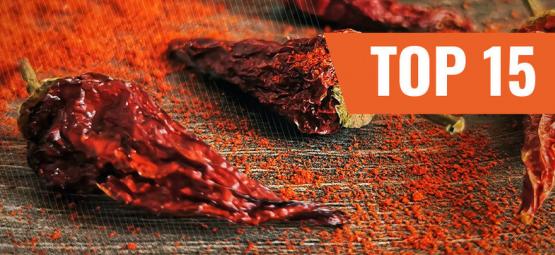
 9 min
5 October 2021
Top 15 Hottest Peppers In The World (2025 Edition)
How does a chili become the hottest in the world? We take a look at the 15 most potent peppers you'll want to get your hands on—or perhaps avoid, depending on how well you can handle the heat! We co ...
9 min
5 October 2021
Top 15 Hottest Peppers In The World (2025 Edition)
How does a chili become the hottest in the world? We take a look at the 15 most potent peppers you'll want to get your hands on—or perhaps avoid, depending on how well you can handle the heat! We co ...
-
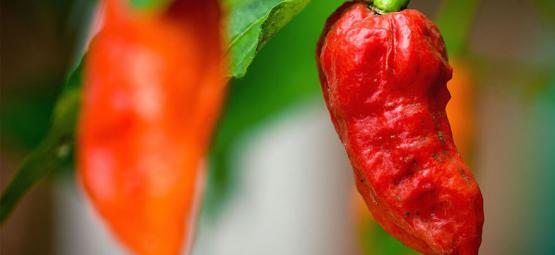
 6 min
24 September 2021
Ghost Pepper (Bhut Jolokia): How To Grow And Use
Ready to put your spice limit to the test? The ghost pepper is synonymous with massive heat, but it also has some big flavours to showcase too. If you've ever wanted to cultivate these chili peppers a ...
6 min
24 September 2021
Ghost Pepper (Bhut Jolokia): How To Grow And Use
Ready to put your spice limit to the test? The ghost pepper is synonymous with massive heat, but it also has some big flavours to showcase too. If you've ever wanted to cultivate these chili peppers a ...
-
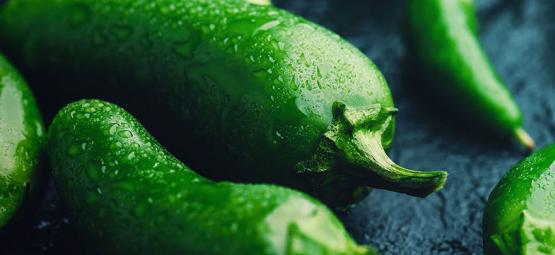
 7 min
6 September 2021
Jalapeño Pepper: How To Grow And Use
While not as mind-blowingly hot as, say, the ghost pepper or habanero, there's still plenty to love about the jalapeño. It's arguably many people's first step into the world of spicy foods, but did y ...
7 min
6 September 2021
Jalapeño Pepper: How To Grow And Use
While not as mind-blowingly hot as, say, the ghost pepper or habanero, there's still plenty to love about the jalapeño. It's arguably many people's first step into the world of spicy foods, but did y ...
-

 7 min
12 August 2021
Growing Peppers For Beginners In 10 Easy Steps
Growing peppers at home can be a hugely rewarding task. Harvesting your own carefully cultivated chilies to use in cooking is a great feeling. But, from seed to harvest, how do you achieve this? We've ...
7 min
12 August 2021
Growing Peppers For Beginners In 10 Easy Steps
Growing peppers at home can be a hugely rewarding task. Harvesting your own carefully cultivated chilies to use in cooking is a great feeling. But, from seed to harvest, how do you achieve this? We've ...
Categories
-
Seedshop
- Feminized Cannabis Seeds
- Autoflowering Cannabis Seeds
- Regular Cannabis Seeds
- F1 Hybrids
- CBD Seeds
- Zamnesia Seeds
- Top 10 Autoflowering Seeds
- Top 10 Regular Seeds
- Top 10 USA Cannabis Strains
- Top 10 Zamnesia Seeds
- Top 10 Feminized Seeds
- Beginner Strains
- Below 1% THC
- Classic Cannabis Strains
- Cup Winners
- F1 Hybrids
- Fast-Flowering Strains
- High CBD Strains
- High THC Strains
- Mix Packs
- Zamnesia Exclusive Collabs
- Amnesia Seeds
- Blueberry Seeds
- Cheese Seeds
- Diesel Seeds
- Gorilla Seeds
- Haze Seeds
- Kush Seeds
- Purple Seeds
- Skunk Seeds
- White Widow Seeds
- Zamnesia Seeds
- ACE Seeds
- Advanced Seeds
- Amsterdam Genetics
- Anesia Seeds
- Auto Seeds
- Barney's Farm
- Big Buddha Seeds
- Bomb Seeds
- BSB Genetics
- BSF Seeds
- Buddha Seeds
- Bulldog Seeds
- Cali Connection
- Cannarado Genetics
- CannaBioGen
- CBD Crew
- CBD Seeds
- Compound Genetics
- The Dank Seeds
- Dark Horse Genetics
- Delicious Seeds
- Devil Harvest Original
- Dinafem
- DNA Genetics
- Doctor's Choice
- Dr. Underground
- Dutch Passion
- Elite Seeds
- Eva Seeds
- Exotic Seed
- Expert Seeds
- FastBuds
- Female Seeds
- Fenocan
- Flash Auto Seeds
- French Touch Seeds
- Garden of Green
- GeneSeeds
- Genehtik Seeds
- G13 Labs
- Grass-O-Matic
- Greenhouse Seeds
- Grow Your Own (DNA)
- Growers Choice
- Homegrown Fantaseeds
- House of the Great Gardener
- Humboldt Seed Company
- Humboldt Seed Organization
- Kalashnikov Seeds
- Kannabia
- The Kush Brothers
- Light Buds
- Little Chief Collabs
- Medical Seeds
- Ministry of Cannabis
- Mr. Nice
- Nirvana Seeds
- Original Sensible
- Paradise Seeds
- Perfect Tree
- Pheno Finder
- Philosopher Seeds
- Positronics Seeds
- Purple City Genetics
- Pyramid Seeds
- Rare Dankness
- Reggae Seeds
- Reserva Privada
- Resin Seeds
- Ripper Seeds
- Royal Queen Seeds
- Sagarmatha Seeds
- Samsara Seeds
- Seedstockers
- Sensation Seeds
- Sensi Seeds
- Serious Seeds
- Silent Seeds
- Soma Seeds
- Spliff Seeds
- Strain Hunters
- Sumo Seeds
- Super Sativa Seed Club
- Super Strains
- Sweet Seeds
- T.H. Seeds
- Top Tao Seeds
- Vision Seeds
- VIP Seeds
- White Label
- World Of Seeds
- Zativo Seeds
- Seed Banks
-
Headshop
-
Vaporshop
-
Healthshop
-
Smartshop
- Top 10 Smartshop
- Zamnesia Gift Cards
- After Party
- Aphrodisiacs
- Aromatherapy
- Blue Lotus
- CBD Vape Juice
- Capsule Machines
- Crystals, Gemstones & Minerals
- Dream Herbs
- Drug Tests
- Extracts
- Happy Caps
- Herbal Tea
- Herbs & Seeds
- Incense
- Kanna
- Kratom
- LSA Seeds
- Mescaline Cacti
- Microdosing
- Nootropics
- Relaxing
- Salvia divinorum
- Smart Seeds
- Stimulants
- Supplements
- Tinctures
- Vape Herbs
-
Shroomshop
-
Growshop
- Top 10 Growshop
- Top 10 Plant Seeds
- All Seeds
- Cacti
- Chili & Pepper Seeds
- Companion Plants
- Edible Plant Seeds
- Exotic Seeds
- Flower Seeds
- Fruit Seeds
- Herb Seeds
- Interior Plant Seeds
- Microgreens
- Psychoactive Plant Seeds
- Sprouting
- Vegetable Seeds
- Wellness Plant Seeds
- After Harvest
- Climate Control
- Fertilizer
- Grow Tents
- Harvest, Dry & Cure
- LED Grow Lights
- Plant Seeds
- Propagation
-
Merchandise
-
Sale section
Account
Information
Our Offers
Our website won't work without these cookies activated. Therefore functional cookies can't be disabled.























